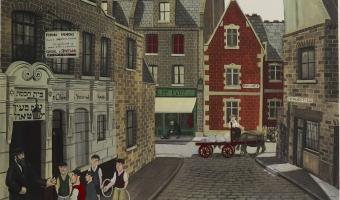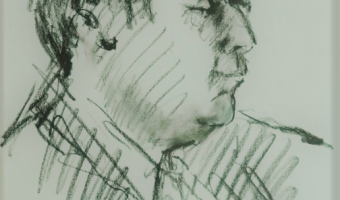David Bomberg: A Pioneer of Modernism
David Bomberg was born to Polish-Jewish immigrant parents in Birmingham, England, in 1890. The family moved to Whitechapel in 1895, where he became prominent among the ‘Whitechapel Boys’ - a group of young, Jewish, mainly immigrant artists who were either born, raised or worked in the East End in the first two decades of the 20th century, and who, both collectively, and individually, made an important contribution to British modernism. As a young man, Bomberg was initially apprenticed as a chromolithographer, attending night classes under Walter Sickert and also working as an artist’s model before studying at the Slade School of Fine Art, where he was seen as a ‘disturbing influence’. In 1913 he visited Paris with Jacob Epstein and made contacts among the avant-garde including Modigliani and Picasso. Upon their return they co-curated the so-called ‘Jewish Section’ at the Whitechapel Art Gallery’s exhibition Twentieth-century Art: A Review of Modern Movements showcasing the work of the local Whitechapel Boys alongside some of their European contemporaries. Bomberg’s harrowing service in the trenches during the First World War was compounded by a disastrous experience as a commissioned war artist. His postwar disillusionment is most powerfully expressed in the masterly Ghetto Theatre (1920).
After the war, Bomberg began to tentatively engage with landscape before travelling in 1923 to Jerusalem, where he began to work en plein air for the first time. Following expeditions to Jericho, Petra and Wadi Kelt, he produced a series of detailed, realistic landscapes, which evolved from the tightly topographical into a looser, characteristically expressionistic style, heralding the painterly achievements of his final years. After a series of disappointments in the 1930s and 1940s Bomberg concentrated on portraits of friends, including fellow Whitechapel Boy John Rodker, and family, as well as a series of searching self-portraits. Although only reluctantly granted a Second World War commission to paint a bomb store in 1942, Bomberg produced many drawings and paintings on the subject. During the 1940s and early 1950s he was an influential teacher at the Borough Polytechnic, spawning the Borough Group and the Borough Bottega, and carried out a series of architectural drawings.
Following his visit to Spain in 1929, Bomberg's renewed vigour resulted in a series of works based on the cathedral at Toledo, flowering on his second visit in 1934–35, into dramatic landscapes of the gorge at Ronda and flickering night-time processions during Holy Week. These experiments were curtailed by the onset of the Spanish Civil War, but over a decade later picked up and progressed in the west country, where his loosened handling verged on the abstract, and in Cyprus in 1948. Bomberg's work eventually reached a magnificent fulfillment of his early promise in his maturity upon his final return to Spain. He died in London in 1957.
After the war, Bomberg began to tentatively engage with landscape before travelling in 1923 to Jerusalem, where he began to work en plein air for the first time. Following expeditions to Jericho, Petra and Wadi Kelt, he produced a series of detailed, realistic landscapes, which evolved from the tightly topographical into a looser, characteristically expressionistic style, heralding the painterly achievements of his final years. After a series of disappointments in the 1930s and 1940s Bomberg concentrated on portraits of friends, including fellow Whitechapel Boy John Rodker, and family, as well as a series of searching self-portraits. Although only reluctantly granted a Second World War commission to paint a bomb store in 1942, Bomberg produced many drawings and paintings on the subject. During the 1940s and early 1950s he was an influential teacher at the Borough Polytechnic, spawning the Borough Group and the Borough Bottega, and carried out a series of architectural drawings.
Following his visit to Spain in 1929, Bomberg's renewed vigour resulted in a series of works based on the cathedral at Toledo, flowering on his second visit in 1934–35, into dramatic landscapes of the gorge at Ronda and flickering night-time processions during Holy Week. These experiments were curtailed by the onset of the Spanish Civil War, but over a decade later picked up and progressed in the west country, where his loosened handling verged on the abstract, and in Cyprus in 1948. Bomberg's work eventually reached a magnificent fulfillment of his early promise in his maturity upon his final return to Spain. He died in London in 1957.




